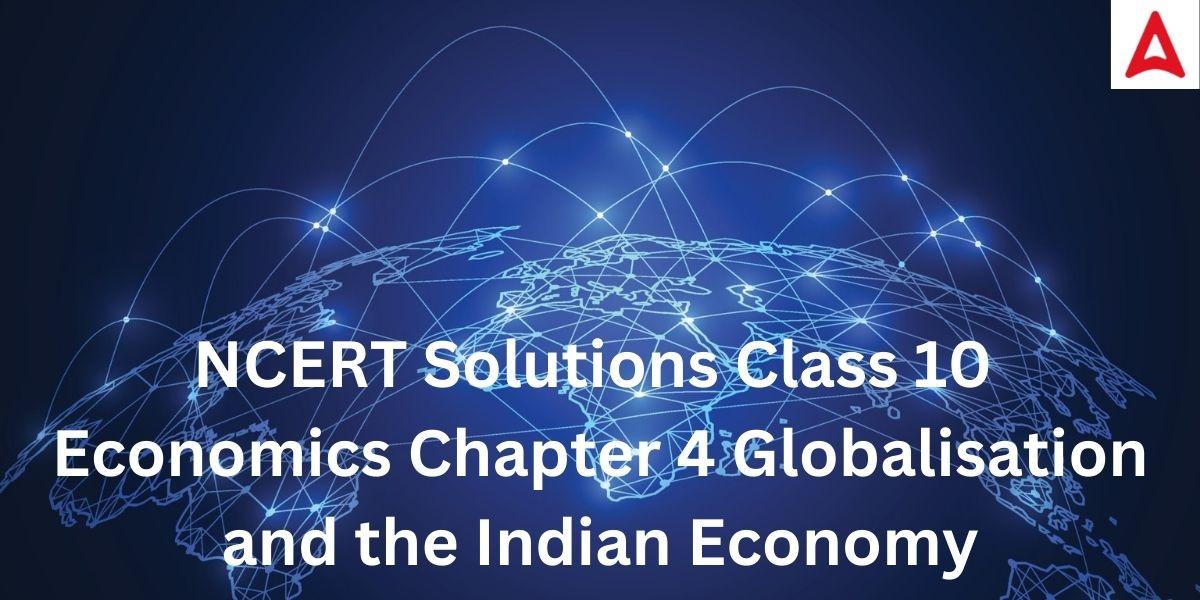Table of Contents
NCERT Solutions Class 10 SST Economics Chapter 4 Globalisation and the Indian Economy Notes
NCERT Solutions Class 10 SST Economics Chapter 2 Globalisation and the Indian Economy notes are given in this article. NCERT Solutions Class 10 is the best resource for obtaining a good score in the class 10 board Examination. Here are Adda247 Expert faculty team prepared NCERT Solutions Class 10 SST Economics Chapter 4 Globalisation and the Indian Economy exercises of that chapter for a better grasp of the topics. These NCERT Solutions answer all questions in an easy and simple manner. These solutions will help you understand the concepts covered in the chapter completely. By writing these answers in the exam students will undoubtedly be able to achieve high scores. Keep learning with Adda247.
Read:NCERT Solutions Class 10 SST Economics Chapter 5 Consumer Rights
NCERT Solutions Class 10 SST Economics Chapter 4 Globalisation and the Indian Economy Pdf
NCERT Solutions Class 10 SST Economics Chapter 4 Globalisation and the Indian Economy is given in pdf format so students can easily download it for future use. Click here to download NCERT Solutions Class 10 SST Economics Chapter 4 Globalisation and the Indian Economy
Class 10 SST Economics Chapter 4 Globalisation and the Indian Economy Video Explanation
NCERT Solution for Class 10 SST Economics Chapter 4 Globalisation and the Indian Economy Summary
Class 10 SST Economics Chapter 4 Globalisation and the Indian Economy describes globalization as the fusion of nations through international trade and foreign direct investment by multinational enterprises (MNCs). Important subjects covered by the students in this chapter include
- Foreign Trade and Integration of Markets
- What is Globalisation?
- Factors that have enabled Globalisation
- Liberalization
- World Trade Organisation
- Impact of Globalisation
NCERT Solutions Class 10 SST Economics Chapter 4- Globalisation and the Indian Economy Questions with Answer
1. What do you understand by globalization? Explain in your own words.
Answer: The term “globalization” refers to the increasing interdependence of the economies, cultures, and populations throughout the world as a result of technology, cross-border trade in goods and services, and flows of capital, people, and information. Globalization is a result of an increase in international trade, immigration, the spread of technology, capital flows, and both private and public investments from other nations. Over many years, nations have developed economic alliances to support these movements.
2. What were the reasons for putting barriers to foreign trade and foreign investment by the Indian government? Why did it wish to remove these barriers?
Answer: Following Independence, the Indian government imposed barriers to international investment and trade. was intended to shield domestic producers and small business owners from overseas competition. This was done to shield domestic producers from international competition, particularly during the 1950s and 1960s when industries were only starting to emerge. The government only permitted the importation of necessities like machinery, fertilizer, and gasoline.
But subsequently, in the 1990s, the government came to understand that reducing these barriers would boost trade and improve the quality of goods produced in the nation, as foreign competition would push Indian industrialists to improve the quality of their products
3. How would flexibility in labour laws help companies?
Answer.Labor law flexibility will help companies in staying competitive and forward-thinking. Employers can negotiate salaries and fire employees based on market factors if labour rules are relaxed. Companies hire people flexibly for brief periods of time when there is high work pressure rather than on a regular basis. This lowers the labour expense for the business. Companies benefit from flexible labour laws because they draw in international investment.
4. What are the various ways in which MNCs set up, or control, production in other countries?
Answer: There are numerous ways that MNCs establish or regulate production in other nations, including:
- MNCs place their production facilities close to the market in order to access labour at a lower cost.
- MNCs work with a few local businesses to boost production since the rate of production would rise quickly.
- MNCs acquire local businesses and use modern technology to increase their productivity. Using advanced equipment and technology to increase the productivity and efficiency of the task.
- They can also control production by giving small producers production orders, and then they can sell the goods to customers around the world under their own brand name.
5. Why do developed countries want developing countries to liberalise their trade and investment? What do you think should the developing countries demand in return?
Answer: Developed countries want developing countries to liberalise their trade and investment Because of the low cost of labour and other resources, manufacturing expenses are lower in developing countries. As a result, MNCs from rich countries can make sizable profits by establishing industries in less expensive developing countries. Additionally, competitiveness is increased by establishing factories and industries in wealthy nations.
In my opinion, developing nations should want some form of protection for indigenous producers against import competition in exchange. Additionally, charges must to be brought against international companies looking to expand into developing nations.
6. “The impact of globalisation has not been uniform.” Explain this statement.
Answer: The impacts of globalization have not been uniform because only developed nations have benefited financially from it. Agriculture has benefited much less from globalisation than have the industrial and service sectors. The industrialised nations are the only ones who profit from setting up enterprises and obtaining cheaper labour in developing nations. Many small manufacturers with limited funding have been unable to compete with powerful MNCs. In light of increased competitiveness, employees are increasingly hired flexibly,as result there is no job security.
7. How has liberalisation of trade and investment policies helped the globalisation process?
Answer: The liberalisation of trade and investment policies helped the globalisation process because it helped remove trade obstacles. By enabling businesses to choose their own import and export policies, liberalisation has contributed to the growth of globalisation.It has facilitated international investment and trade.
Customers now have more options because they can purchase products made not just by domestic but also by international businesses. Because of traders’ competition, prices for goods have decreased and product quality has improved. Globalization is advancing as a result of it enabling industrialised nations to establish their businesses and offices in underdeveloped nations.
8. How does foreign trade lead to the integration of markets across countries? Explain with an example other than those given here.
Answer: Foreign trade leads to the integration of markets across countries Because it gives producers the chance to expand beyond their domestic markets. Foreign commerce has enabled producers to compete and export their goods to marketplaces in other nations. This is advantageous for the purchasers as well. Their options have increased because they can now choose products made not only by home companies but also by foreign companies. Prices for commodities have reduced as a result of increased market competition, and production quality is rising. Therefore, international commerce results in market integration.
9. Globalisation will continue in the future. Can you imagine what the world would be like twenty years from now? Give reasons for your answer.
Answer: If the process of globalisation proceeds in a fair and equitable manner, the globe will continue to become more interconnected and integrated into a single worldwide economy. In twenty years, there will be better productivity in the manufacture of commodities, greater market competition, more innovation in every field, and higher levels of both quality and output. The number of small businesses and entrepreneurs will rise as more chances are made available to them.
10. Supposing you find two people arguing: One is saying globalisation has hurt our country’s development. The other is telling, globalisation is helping India develop. How would you respond to these arguments?
Answer: There are several benefits and drawbacks associated with globalisation, which is becoming more prevalent in the nation.
The benefits of globalization include:
- Trade volume, employment possibilities, and the range of items available to consumers on the market have all increased.
- Increasing competition in the industry has resulted in an improvement in product quality.
The drawbacks of globalization include
- Small-scale business owners could find it difficult to compete with such multinational corporations and turn a profit.
- One could argue that because we have started to rely on others, globalisation is hurting our progress.
- Since employees are employed “flexibly,” they lack job security.
11. Fill in the blanks.
Indian buyers have a greater choice of goods than they did two decades back. This is closely associated with the process of ______________. Markets in India are selling goods produced in many other countries. This means there is increasing ______________ with other countries. Moreover, the rising number of brands that we see in the markets might be produced by MNCs in India. MNCs are investing in India because _____________ ___________________________________________. While consumers have more choices in the market, the effect of rising _______________ and ______________has meant greater _________________among the producers.
Answer:
Indian buyers have a greater choice of goods than they did two decades back. This is closely associated with the process of globalization. Markets in India are selling goods produced in many other countries. This means there is increasing trade with other countries. Moreover, the rising number of brands that we see in the markets might be produced by MNCs in India. MNCs are investing in India Because of the cheaper production costs. While consumers have more choices in the market, the effect of rising demand and purchasing power has meant greater competition among the producers.
12.Match the following.
| (i) MNCs buy at cheap rates from small | (a) Automobiles producers |
| (ii) Quotas and taxes on imports are used to regulate trade items | (b) Garments, footwear, sports |
| (iii) Indian companies who have invested abroad | (c) Call centres |
| (iv) IT has helped in spreading of production of services | (d) Tata Motors, Infosys, Ranbaxy |
| (v) Several MNCs have invested in setting up factories in India for production | (e) Trade barriers |
Answer:
| (i) MNCs buy at cheap rates from small producers | (b) Garments, footwear, sports items |
| (ii) Quotas and taxes on imports are used to regulate trade | (e) Trade barriers |
| (iii) Indian companies who have invested abroad | (d) Tata Motors, Infosys, Ranbaxy |
| (iv) IT has helped in spreading of production of services | (c) Call centres |
| (v) Several MNCs have invested in setting up factories in India for production | (a) Automobiles producers |
13. Choose the most appropriate option.
1.The past two decades of globalisation has seen rapid movements in
- goods, services and people between countries.
- goods, services and investments between countries.
- goods, investments and people between countries.
Answer: c. goods, services and investments between countries
2. The most common route for investments by MNCs in countries around the world is to
- set up new factories.
- buy existing local companies.
- form partnerships with local companies.
Answer: c. buy existing local companies
3. Globalisation has led to improvement in living conditions
- of all the people
- of people in developed countries
- of workers in the developing countries
- none of the above
Answer: d. none of the above
Found this article helpful?
Let’s connect via chat or call our senior expert counselor at +91-9625869989 to learn more about the different streams and options available. We would love it if we could add some of your insights. If you have a definite goal of scoring the highest marks, then you can resolve your doubts via our app (https://play.google.com/store/apps/details?id=com.adda247.app&referrer=invite_code=8973023) and youtube class assistance (https://www.youtube.com/c/Adda247School)
NCERT Solutions Class 10 SST Economics Chapter 4 Globalisation and the Indian Economy-FAQs
Q.What is globalisation in short?
Globalisation is the process of integrating nations through international business and foreign direct investment (MNCs).
Q.How do I acquire the NCERT Solutions for Class 10 SST Economics Chapter 4 Globalisation and the Indian Economy in an online PDF format?
Ans. you can download the NCERT Solutions for Class 10 SST Economics Chapter 4 Globalisation and the Indian Economy PDF from the link provided in the article.
Q.How can using NCERT Solutions for Adda247’s Economics Chapter 4 for Class 10 SST benefit you?
Ans. The following are some benefits of using Adda247’s NCERT Solutions for Class 10 SST Economics:
- Students are given both the NCERT solution and a video explanation.
- A PDF is also provided, which can be downloaded and saved for future use
NCERT Solutions Class 10 SST Economics Chapter 4 Globalisation and the Indian Economy is prepared by Adda247 Experts. Read NCERT Solutions Class 10 for Economics with video explanation for your CBSE Exam preparation.


 JAC 10th Result 2024 Link Released soon ...
JAC 10th Result 2024 Link Released soon ...
 VIT Admit Card 2024, Release Date and Do...
VIT Admit Card 2024, Release Date and Do...
 PSEB 10th Result 2024 Link Active, Check...
PSEB 10th Result 2024 Link Active, Check...














